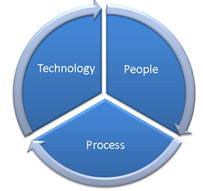IT Operations: Technology Is Not The Sole Answer
Written by Kip Ng, Principal Microsoft Premier Field Engineer
 Most people in IT have a strong tendency to resolve a problem with technology or introducing more technologies into a solution. I‘m guilty on this count too. Well, you know what? Technology is not always the answer. 3 key elements to successful IT operations are People, Process and Technology. Believe it or not, most companies that I’ve come across in my last 15 years in IT support probably spent over 70% of their resources (be it money, time, investment or service) on the last element, technology.
Most people in IT have a strong tendency to resolve a problem with technology or introducing more technologies into a solution. I‘m guilty on this count too. Well, you know what? Technology is not always the answer. 3 key elements to successful IT operations are People, Process and Technology. Believe it or not, most companies that I’ve come across in my last 15 years in IT support probably spent over 70% of their resources (be it money, time, investment or service) on the last element, technology.
Many companies including some of the largest organizations spend a lot of money on technology, buying some of the most expensive hardware, storage and investing in some of the most expensive software, but they spend very little time and money on the People and Process. The fact is that the first 2 elements, People and Process, are equally important and it won’t be stretching to say that many times People and Process are more important than technology.
A People and Process Checklist
You may say that no, no, we definitely didn’t do that. Before you switch into defensive mode, let’s do a quick check to see if you have some of the most essential processes in place, such as:
- a disaster recovery process,
- a well -troubleshooting flow and process,
- an escalation process,
- a well defined change management process,
- an emergency response process,
- a business continuity process,
- and the list goes on.
Are all the processes well thought out? What about people? Do all the people in your team have the appropriate skill level? Are they geared towards operations excellence? Are there well defined roles for your people? I’m only looking at the tip of the iceberg here. The truth is that this is not just limited to IT operations but also extends to all IT projects.
How often do you see a project being implemented, servers installed and applications deployed with absolutely no focus given to disaster recovery processes, people training, troubleshooting workflow, appropriate documentation, etc? Oh, almost every time. People and Process seem to be the after-thought in many projects. I’ve worked in different regions around the world and can tell you this behavior is universal'; it happens in Asia, it happens in Europe and hey, North and South America are no exceptions.
A Real World Example
Here’s one example: I had a customer who wanted to deploy Microsoft Operations Manager (MOM) to monitor their data center. So they slapped MOM into the environment according to the installation guide, deployed the agents on all the servers, installed the management packs and left it as it is, expecting this piece of Technology to do their job, alerting them of major issues. The experience and result were disappointing and the customer blamed it on the product. I was onsite to provide knowledge sharing on a different product and this topic came up. I spent almost half a day explaining what in essence can be boiled down to the following:
- Technology (in their case) is just a piece of software. MOM is a great product, but it’s still just a program that has no intelligence other than some rules defined by people. They still need people to monitor the console and make sound judgments on what needs to be done.
- Technology is an enabler but not a replacement for process and people. Perhaps one day, technology will have enough fuzzy logic to think somewhat intelligently for itself (like those robots in Terminator) but, until then, it is no replacement for people and processes. You need People to define the processes, Processes to define the events and Technology to enable those processes.
In short, Technology is only as good as the Processes that define the program and the People who defined those processes. Remember those days in banks, where we worked without any computers and software? Obviously with computer and software, everything become more efficient but it isn’t a complete replacement of process and people, it enhances it. Technology alone is not the complete answer. Hopefully, next time when you deploy a IT project, you won’t just think about the technology but also the processes involved to support it and the people you need to run it and to make the project successful.
